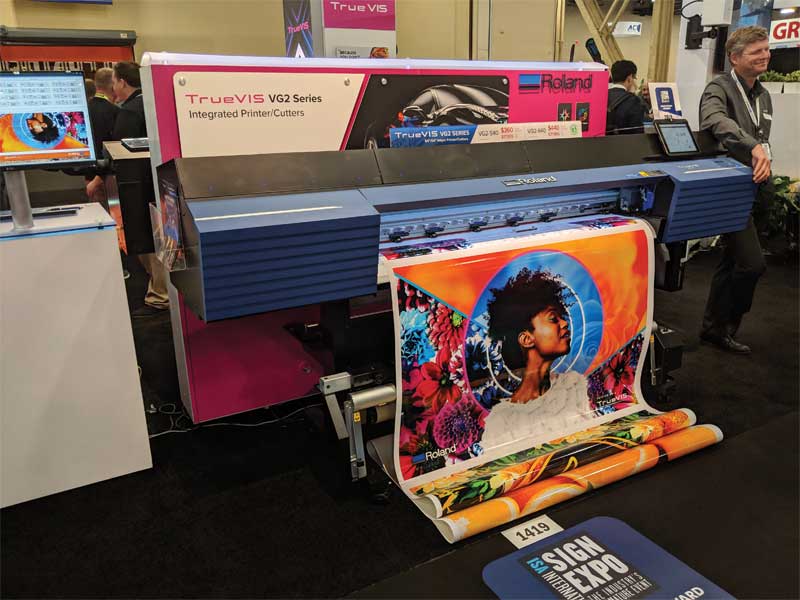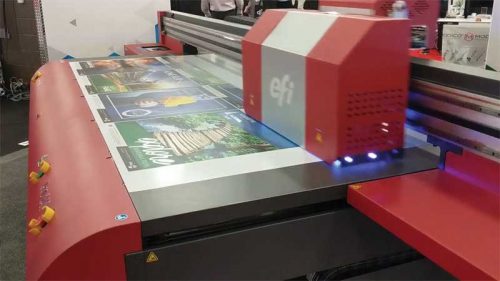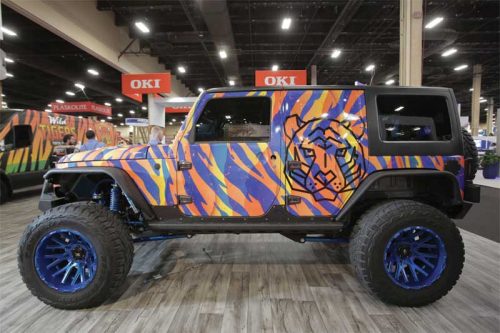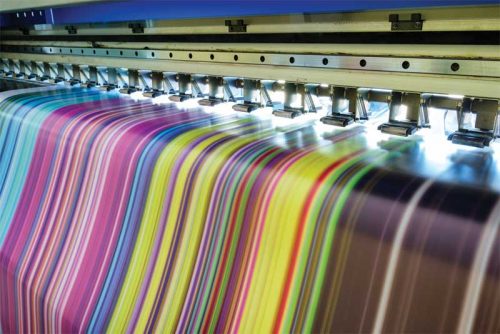The Visual Communication Space: How wide-format technology can help a printing business break new ground
by | 23 August 2019 8:30 am
By Eve Padula
 [1]
[1]Wide format certainly presents itself as a lucrative opportunity for a sign company to grow into a full-service provider, allowing professionals to offer a full spectrum of print campaigns for film studios and advertising agencies.
Visual communication—which relies completely or partially on eyesight—is the transmission of information and ideas using symbols and imagery. It is one of the three primary types of communication, including verbal (speech) and non-verbal (tone, body language, etc.) methods. According to David N. Hyerle and Larry Alper’s book Student Successes with Thinking Maps, the human brain processes images 60,000 times faster than text. Further, 90 per cent of the information transmitted to the brain is visual. Most people rely on visual communication, but this category is extremely broad and the examples are infinite. Some of the most popular forms of visual communications include signage, graphic design, films, advertising, and typography.
This mode of communication has long been an integral component of most brand owners’ advertising efforts, primarily because most consumers rely heavily on it. Visuals are also vital to establish an ongoing dialogue between enterprises and customers. This article discusses the importance of personalization in creating a quality customer experience, provides tactics for maximizing efficiency and showcasing capabilities, and highlights a few examples for learning to think like big brand owners, major retailers, and their designers.
Customer experience is key
Although customer experience includes several components, it simply means a consumer’s perception of a brand. Most sign businesses may view their brand a certain way, but a consumer might perceive it as something entirely different. This opinion is the actual customer experience.
For many companies, personalization and customization are key to creating eye-catching visual messages that not only get noticed, but also drive consumers to take action. By creating more targeted, relevant, and valuable communications, signmakers can improve their overall customer experience.
A printing company may think it is firmly rooted in visual communications, but this means little if customers still view it as a sign and graphics provider.
Today’s wide-format display graphics printers must “walk the walk” and ensure their customers are aware of their visual communications capabilities. There are many key points print-service providers (PSPs) can focus on to ensure they are positioning themselves appropriately in this evolving industry.
Learn to think like a visual communications company
 [2]
[2]Custom displays can be used to create an eye-catching, and even interactive, experience in a variety of locations, including trade shows, events, conferences, retail stores, and office buildings.
Visual communications like signs, banners, and point-of-purchase (POP) displays are particularly appealing because they are
not being displaced by digital alternatives. Although many commercial printers understand the opportunities that exist within visual communications, breaking into the market involves more than just having proper printing hardware.
Many printers believe succeeding with wide format requires the right combination of finance, technology, colour management expertise, physical space, finishing capabilities, and strategic planning. One simply cannot invest in a device and think it would make them a grand-format print provider; they need to make numerous investments to facilitate this shift. That said, wide format certainly presents itself as a lucrative opportunity for a sign company to grow into a full-service provider, allowing professionals to offer a full spectrum of print campaigns for film studios and advertising agencies.
Offering visual communications in conjunction with commercial printing services can generate additional business from existing customers. Since all the services are consolidated under a single roof, customers can easily place a wide-format order. This trend also works in reverse, when wide-format buyers discover a printing company owns a six-colour, 965.2-mm (38-in.) web offset press.
Understand their challenges
While many commercial printers view visual communications as a natural extension to the services they already provide to existing clients, fully transitioning into the visual communications industry is not without its challenges. Building a substantial wide-format business—either organically or via acquisitions—requires financial support for equipment, which not all printers can sustain.
Although many printing and graphic arts companies today handle wide-format production on a national scale, it was a difficult process for them to get accustomed to. For example, creating an advertising campaign for the 2006 mystery thriller The DaVinci Code was a tough lesson for the printing company, but also an important experience as it taught them how to handle scores of bulletins—standard 4.3- x 14.6-m (14- x 48-ft) outdoor billboards—imaged on clear backlit substrates. The company had completely reorganized its workflow around wide-format printing a few years ago and had added several finishing capabilities so they could take on bigger projects. Thus, when it came to crafting a brand experience for a motion picture of this scale, the print provider had the necessary equipment (and capabilities) to execute a successful campaign.
Be prepared
Responding to a client’s demands requires a thorough understanding of market trends, as well as preparedness. A print provider can better address these requests by maximizing their overall efficiency and ensuring their existing and potential customers truly understand their production capabilities. PSPs must keep a few things in mind to maximize their potential.
Selecting the right printing technology
Smart equipment investments can offer efficient, well-organized operations. The key to offering and promoting custom graphics is to ensure the printing equipment matches the application’s needs. Wide-format inkjet technology comes in many forms—from true flatbed printers to roll-to-roll and hybrid printing devices. Before purchasing a new printer, a PSP should consider the following:
- Is there a need to print on flexible or rigid substrates, or a mixture of both?
- How much roll versus rigid work will be required in the future? Will a dedicated roll-to-roll printer be needed?
- What ink formulation is used in the printer?
- Do substrates need to be pretreated, or are post-print steps required that may add time and costs?
- How many colours can the device print? Is
it capable of handling brand colours? - Does the printer produce the quality of output customers require, and can it print those quality modes fast enough to meet turnaround times?
- Are white, clear, or other specialty inks needed?
Additionally, running the printer with the right digital front end to deliver fast raster image processing power, industry-leading colour, and efficient print job management tools is critical. This helps achieve superior results and maximizes productivity and profit from business insights with integration into the print management software tools.
Understanding the latest print management software
An understanding of the latest print management and web-to-print technologies enables a business to better serve its customers and maximize efficiency. For sign companies that need to organize core business processes, a management information system (MIS) or an enterprise resource planning (ERP) solution is a great option. Implementing these systems can enable a company to run their print business smoothly and identify growth plans.
If the business is prepared to enter e-commerce or web-to-print, the right system can bring it up to speed. For example, a print MIS system offers display graphics printers an integrated software solution designed to increase visibility and streamline operation, providing increased margins, faster turnaround times, and improved customer service to promote repeat orders. The software serves as a one-data access point for an entire print operation—from e-commerce through to estimating, production, and shipping. This solution has the tools to meet a company’s current demands while being flexible enough to evolve with the business as it expands into different markets and undertakes new production processes in the future.
Show customers what the business can do
 [3]
[3]Custom displays can be used to create an eye-catching, and even interactive, experience in a variety of locations, including trade shows, events, conferences, retail stores, and office buildings.
Custom displays can be used to create an eye-catching, and even interactive, experience in a variety of locations, including trade shows, events, conferences, retail stores, and office buildings.
Once a print business has maximized its efficiency by ensuring its hardware, software, and workflow are up-to-date, it is then time to show customers what they are capable of. Visual communications are everywhere, and they incorporate a vast array of text, images, logos, designs, colours, textures, and special effects. These elements can, and should, be leveraged to promote a business’s offerings and capabilities; PSPs need to think beyond printed signs. The subsections below provide some examples of visual communications.
Custom displays with integrated printed graphics
Custom displays can be used to create an eye-catching, and even interactive, experience in a variety of locations, including trade shows, events, conferences, retail stores, and office buildings. These displays are designed to draw the customer’s attention to a brand, product, or service with 3D elements and printed images, using rich, vibrant colours and textures. Integrated printed graphics, such as backdrops, window clings, and backlit displays, can be used to create an even more engaging customer experience.
Floor, window, and wall applications
Floor, window, and wallcoverings can be used in a range of settings for different purposes. In a retail store, they can be used to direct patrons to a specific area for product demonstrations, free samples, special sale items, educational workshops, raffles, etc. These visual elements can also be used in doctor’s offices, schools, libraries, law offices, and other public buildings as wayfinding signage to help visitors navigate their surroundings. Some of these images are designed for outdoor use to entice passersby to visit a store, event, or other location on a whim. This type of location-based marketing is a great way of attracting new customers who may not be aware of the business or its offerings.
Soft signage and fabric displays
Soft signage and fabric displays are lightweight, foldable, and reusable, making the products easy to transport, inexpensive to ship, and simple to assemble and store. Most importantly, soft signage has a higher-value look and feel. A few examples include pop-up displays, flags, banners, backlit displays, and point-of-purchase displays. This type of signage is typically printed using dye sublimation techniques, which produce vivid graphics with superb colour saturation, sharp text, and compelling images. Finished graphics can be washed, dried, and folded without damaging the print.
 [4]
[4]
Colour is a key component of any brand’s identity; therefore, the ability to produce consistent, accurate colours across all phases of the printing process and through the raster image processor (RIP) is paramount.
Window graphics
Window graphics are a great way for physical establishments (e.g. restaurants, supermarkets, health clubs, etc.) to attract attention from local consumers. These graphics can be produced using vinyl or film, can be used indoors or outdoors, and are available for short-term or long-term display. Some graphics, such as window films, are easy to remove and come off clean, while others, such as etched glass film and contour-cut vinyl, are designed to last for years. Perforated window film is a unique application as its graphics can be seen from the outside of the building, but people who are inside can see right through the glass. Translucent vinyl graphics diffuse light evenly to produce vibrant colours and can be used with illuminated windows.
White and/or clear inks are highly recommended as they can transform any design into a stunning display. For example, in 2018, a digital printing innovation centre installed printed graphic film on all of the floor-to-ceiling glass doors and windows of its conference rooms. The window graphics were designed with white ink to create opacity and bold patterns. Clear inks were used in other parts of the design to create translucent areas within the frosted colour. The graphics were then printed onto a film, using a specialized hybrid flatbed/roll-fed printer. The finished output helped create a sense of privacy for meetings inside the conference room yet enabled visibility of movement outside. The rooms were also equipped with matching chairs and printed wallcoverings to complement the colourful design concept.
Industry expansion continues
Industry trends suggest the wide-format printing business has become much broader over the past several years, and lines that used to separate various establishments have begun to blur. As such, it is more important than ever for brand owners to develop a targeted marketing strategy. This approach allows businesses to think about the customers they do not need to reach just as much as they think about the ones they do hope to influence. PSPs can begin by asking themselves the following questions:
- Who are their current customers, and what products do they buy from the company? Are there any other areas the business could expand into based on consumers’ needs? Are there adjacent markets that might have a similar need for the company’s offerings?
- Who are the company’s competitors targeting? How can one set their business apart and avoid price-driven battles?
- What are the key features of the company’s offerings? Which consumers and/or businesses could benefit from these products? What are the best ways one can reach these prospects?
- Should one’s business target specific consumer demographics (e.g. age, gender, income level, family status) or business demographics (e.g. location, size, industry)?
Answers to these questions will enable a print provider to market their visual communications in the most effective way possible. Since the industry has become so vast, it is crucial the company’s sales personnel has a clear understanding of the business’s offerings, so they can effectively market them to customers and prospects. Clients will not be able to request services if they do not know they exist!
Eve Padula is the senior writer/editor for Keypoint Intelligence—InfoTrends’ business development strategies, customer communications, and wide-format consulting services. Her responsibilities include the promotion and distribution of content, assisting clients and channels in building business development programs, handling data analysis for forecasts and research reports, and managing the editing cycle for many types of deliverables. This article is based on a white paper she prepared for the International Sign Association (ISA) that was sponsored by Electronics for Imaging (EFI). For more information, visit www.signs.org.
- [Image]: https://www.signmedia.ca/wp-content/uploads/2019/08/MVIMG_20190425_133441_1.jpg
- [Image]: https://www.signmedia.ca/wp-content/uploads/2019/08/Screenshot_20190801-094810.jpg
- [Image]: https://www.signmedia.ca/wp-content/uploads/2019/08/LmbdgAVU.jpg
- [Image]: https://www.signmedia.ca/wp-content/uploads/2019/08/bigstock-Large-Inkjet-Printer-Working-M-273005341.jpg
Source URL: https://www.signmedia.ca/visual-communication-space-how-wide-format/